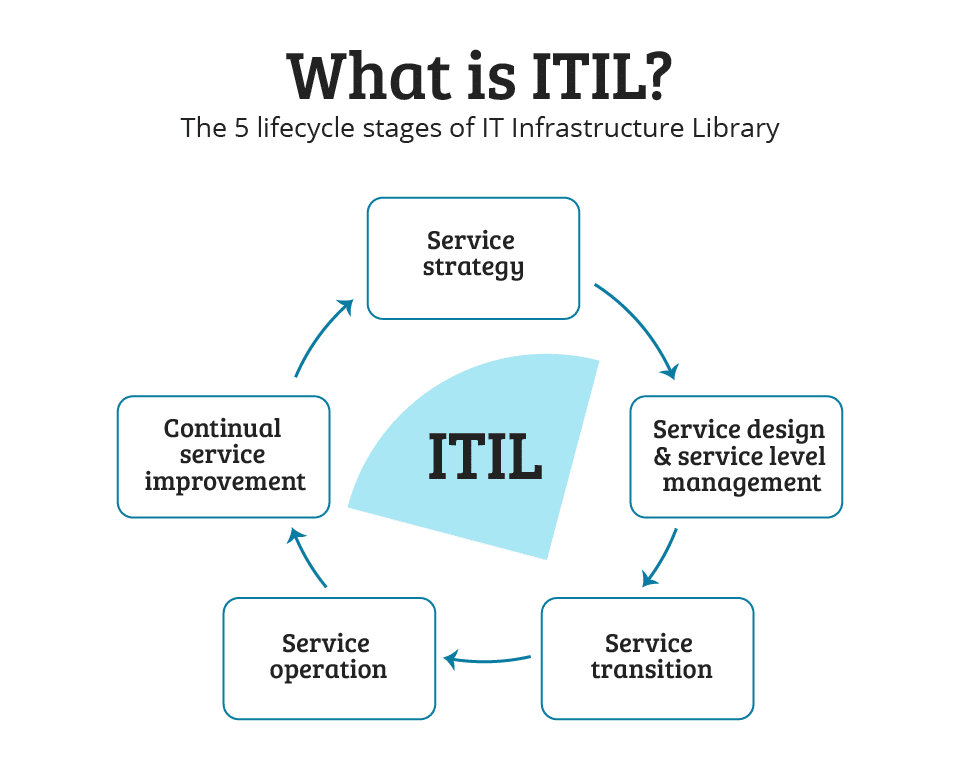What is ITIL?
ITIL, short for Information Technology Infrastructure Library, is a framework of best practices for delivering IT services, focusing on aligning IT operations with business needs to maximize value.
What is ITIL and why use it?
Like mentioned above, ITIL is a framework with best practices for delivering IT services.
While the IT world started ITIL, you can apply its principles in other areas. For example, Facilities and HR departments can benefit from them.
You can maximize value to the business by aligning your organization’s processes and services with your business needs. Applying ITIL offers multiple advantages by:
- Giving input for process improvements and helping to solve service delivery issues.
- Stimulating process-based thinking and working, while making the effects of doing this visible.
- Introducing a general terminology used by service providers and customers, so that everyone is always on the same page.
How does ITIL relate to ITSM?
ITIL is often mentioned in the same breath as ITSM, short for Information Technology Service Management. When you’re looking to improve your services, it’s important to realize you’re not facing a choice between either ITIL or ITSM.
It is one of the existing frameworks that offer best practices on what to do as an organization when you implement ITSM. And ITSM is all about how your organization manages the IT services you deliver to your customers.
Want to read more? Check out the guide on ITSM.
Why is ITIL needed?
ITIL is a must-have in order to improve your IT service management. It provides a structured framework that can help:
- Enhance service quality: ITIL offers best practices to deliver high-quality IT services consistently.
- Increase efficiency: Streamlined processes reduce waste and improve productivity.
- Facilitate continuous improvement: ITIL encourages regular assessment and enhancement of processes.
- Align IT with business goals: Ensures IT services support the overall objectives of the organization.
- Improve customer satisfaction: Better management of services leads to higher customer satisfaction.
- Reduce costs: Efficient processes and better resource management can lead to cost savings.
- Manage risk: Provides guidelines to identify, assess, and mitigate risks effectively.
In summary, ITIL helps deliver better IT services, align with business goals, and continually improve operations.
Digitize your IT service desk with ITIL-compliant ITSM software
Looking for the right ITSM solution? TOPdesk’s ITSM software is built on ITIL best practices and brings your IT services together in one place – making it easy to share knowledge, answer questions and solve problems. You’ll give agents time to spare, and customers a reason to be happy.
Learn more
The 5 lifecycle stages of ITIL - What is ITIL? TOPdesk Glossary
ITIL V3 – the five lifecycle stages
ITIL V3, or the Information Technology Infrastructure Library version 3, came out in 2011. It outlines five key lifecycle stages that are essential for effective IT service management. These ITIL service lifecycle consists of the following stages: Service Strategy, Service Design, Service Transition, Service Operation, and Continual Service Improvement.
1. Service strategy
This stage focuses on understanding the needs of your customers and aligning IT services with business objectives and the overall business strategy. It involves defining the market, developing a service portfolio, and ensuring that the right resources are in place to deliver value.
2. Service design and service level management
Here, the goal is to design new IT services or modify existing ones to meet the requirements identified in the Service Strategy phase. This includes creating service level agreements (SLAs), designing processes, and ensuring that the necessary technology and architecture are in place.
3. Service transition
This stage is all about planning and managing the transition of new or changed services into the live environment. It includes testing, training, and ensuring that all stakeholders are prepared for the changes. Effective communication is key during this phase to minimize disruption.
4. Service operation
Once services are live, the focus shifts to delivering and managing those services effectively. This involves monitoring performance, resolving incidents, and ensuring that services are delivered according to the agreed-upon SLAs. The goal is to provide a seamless experience for users while maintaining high service quality. For example, Incident Management and your organization’s service desk are part of this stage.
5. Continual service improvement
The final stage emphasizes the importance of ongoing improvement. Organizations should regularly assess their services and processes to identify areas for enhancement. This could involve gathering feedback from users, analyzing performance metrics, and implementing changes to improve efficiency and effectiveness.
By understanding and implementing these five lifecycle stages, organizations can create a robust ITSM framework that not only meets the needs of their customers but also drives business success.
Introducing ITIL 4
ITIL 4 was introduced 8 years after ITIL V3, in 2019. With ITIL 4, the framework was updated to be more flexible and collaborative.
While it keeps the core ideas, ITIL 4 introduces the Service Value System (SVS), which includes things like the Service Value Chain, guiding principles, governance, practices, and continual improvement. Instead of the old lifecycle stages, ITIL 4 focuses on creating value through a more integrated and adaptable approach.
So, while ITIL V3 had five specific stages, ITIL 4 offers a fresh way to manage services, making it easier to adapt and create value.
ITIL 4 vs. ITIL V3
ITIL 4 doesn’t use the same lifecycle stages as ITIL V3. Instead, it offers a more flexible and all-around approach with the ITIL Service Value System (SVS).
The SVS includes:
- Guiding principles: Tips to help your organization in any situation.
- Governance: How your organization is directed and controlled.
- Service Value Chain: Activities that work together to deliver valuable products or services.
- Practices: Resources and methods for getting work done.
- Continual improvement: Ongoing activities to keep improving performance.
What is the Service Value Chain in ITIL 4?
A key part of the SVS is the Service Value Chain. Similar to the lifecycle stage we saw above with ITIL V3, there are six activities that you should pay attention to in order to create value:
- Plan: Making sure everyone understands the vision and current status, and knows the direction for improvement.
- Improve: Continuously enhancing products, services, and practices.
- Engage: Understanding stakeholder needs and maintaining good relationships.
- Design and transition: Ensuring products and services meet expectations for quality, cost, and time.
- Obtain/build: Making sure service components are available when needed and meet specifications.
- Deliver and support: Ensuring services are delivered and supported as expected.
In short, ITIL 4 focuses on the Service Value System and the Service Value Chain, offering a more integrated and adaptable way to manage and deliver IT services compared to the stages in ITIL V3.
Curious to learn more about how to navigate ITIL V3 and ITIL 4? Check out the full blog on ITIL service lifecycle.

Six guidelines for successfully implementing ITIL
To successfully implement ITIL (and provide better services), organizations should consider the following six guidelines:
1. Understand your needs
Before diving into ITIL practices, take the time to assess your organization’s specific needs and challenges. This understanding will help tailor ITIL processes to fit your unique environment, ensuring that the implementation is relevant and effective.
2. Engage stakeholders
Involve key stakeholders from various departments early in the process. Their insights and feedback are invaluable for creating a service management framework that meets the needs of the entire organization. Engaging stakeholders fosters a sense of ownership and encourages collaboration.
3. Start small
Rather than attempting to implement all ITIL processes at once, begin with a few key areas that will have the most immediate impact. This phased approach allows for manageable changes and provides opportunities to learn and adapt before expanding to other areas.
4. Provide training and support
Provide your team with the training and resources they need to understand and use ITIL effectively. Continuous support and education will ensure everyone is aligned and can help make the implementation successful.
5. Measure and monitor
Establish clear metrics to evaluate the effectiveness of your ITIL processes. Regularly monitor these metrics to identify areas for improvement and to ensure that the services provided are meeting organizational goals. This data-driven approach will help you make informed decisions.
6. Foster a culture of continuous improvement
Encourage a mindset of continual improvement within your organization. This means regularly reviewing processes, seeking feedback, and being open to change. By creating a culture that values improvement, you can keep your ITIL implementation relevant and effective over time.
Conclusion
By following these guidelines, organizations can effectively implement ITIL practices that enhance service delivery and drive overall business success. Embracing ITIL is not just about following a set of processes. It is about creating a culture that values quality, efficiency, and continuous improvement in IT service management.
Not sure if ITIL is a good fit for you?
Then check out our e-book on Best Practices for Service Management. Unlike ITIL, Best Practice Service Management (BPSM) focuses on customer satisfaction over tools and processes. Download the e-book to discover a set of flexible best practices for happy customers and great services.
Download the e-book